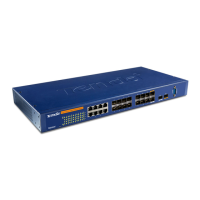24-Port Managed Gigabit Switch
(TCP) that uses the Internet Protocol (IP). Unlike TCP, UDP
does not provide the service of dividing a message into packet
datagrams, and UDP doesn't provide reassembling and
sequencing of the packets. This means that the application
program that uses UDP must be able to make sure that the
entire message has arrived and is in the right order. Network
applications that want to save processing time because they
have very small data units to exchange may prefer UDP to
TCP.
UDP provides two services not provided by the IP layer. It
provides port numbers to help distinguish different user
requests and, optionally, a checksum capability to verify that
the data arrived intact.
Common network applications that use UDP include the
Domain Name System (DNS), streaming media applications
such as IPTV, Voice over IP (VoIP), and Trivial File Transfer
Protocol (TFTP).
User Priority
User Priority is a 3-bit field storing the priority level for the
802.1Q frame.
V
VLAN
Virtual LAN. A method to restrict communication between
switch ports. VLANs can be used for the following applications:
VLAN unaware switching: This is the default configuration.
All ports are VLAN unaware with Port VLAN ID 1 and members
of VLAN 1. This means that MAC addresses are learned in
160

